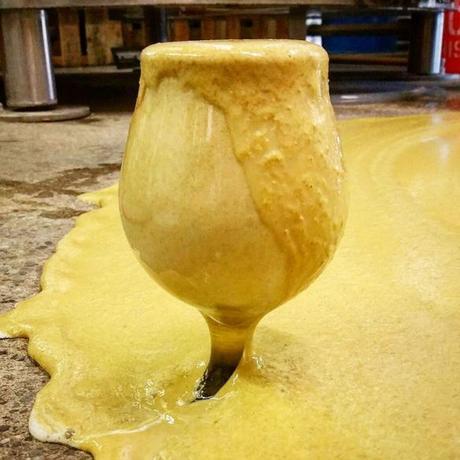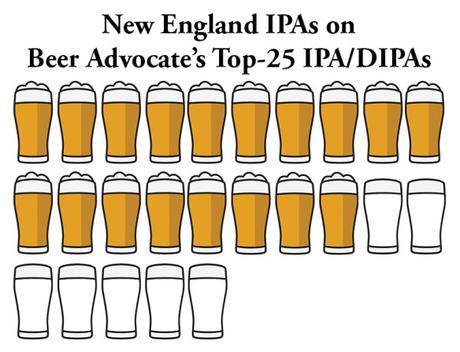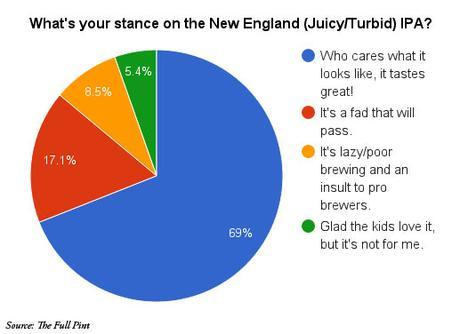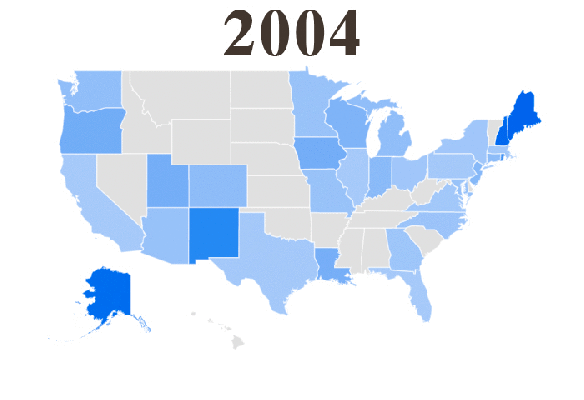
The more I read and write about the beer industry, the stronger I feel that American beer culture should often be seen through hop-tinted glasses. The IPA, a defining American style, is " almost like an adjective for American brewing," as recently pointed out by Jeff Alworth.
Everywhere you turn, IPA is having some sort of impact on consumer buying decisions, brewery production choices and the fate of some of our beloved, heritage brands. Jeff and I are on the same wavelength: hops have done incredible things for the American beer industry and through this prism, evolution and innovation continues to happen. American ingenuity pairs well with America's favorite craft beer.
Which is all part of the reason why I've been watching with great interest the most recent development of the Northeast/New England IPA. There have been many stages of growth from when Sierra Nevada and Russian River started the modern hop-forward movement to today, bringing us from bitingly bitter, malt-balanced, fruity and cloudy IPAs. But what we see now with the NE IPA is a giant venn diagram converging. Aspects of our brewing culture are coming together, showing maturation of the industry and its drinkers.
The NE IPA isn't just a trend. It's a part of the broader cultural implications of beer.
To put the popularity of NE IPAs into context, consider that of the top-25 IPAs and DIPAs found on Beer Advocate, 18 of them (72 percent) are some variation of NE IPA*, based firstly on aesthetics with its telltale cloudy haze and flavor attributes of intense juice/fruit flavors. Of the rating sites available, Beer Advocate shows the greatest variation of its top beers thanks to their proprietary rating formula, so following trends through these beer enthusiasts generally reflects "what's hot" in the moment for craft beer.

In a recent poll on The Full Pint, 70 percent of respondents said they have tried a NE IPA with nearly that same amount noting their "stance" on the style was an accepting one.

A pivotal part of any industry is recognizing inefficiencies to position you and your product in a distinctive manner. In a 2007 study analyzing success rates of newly launched products from across a variety of business sectors, the top 20 percent of businesses averaged 38 percent of their sales during a three-year period from new products. The rest were at 27 percent. New products for that top-20 provided 42.4 percent of their profits while it was 28.4 percent for the rest.
I use this example to emphasize the value in creating new brands and styles. As an experiential good, you *must* drink a beer in order to subjectively determine its value to you. New and novel ( even more so, rare) beers have a leg up, if only for their air of mystery. There's a reason "seasonal" and "variety" are the second and third-best selling beer styles in IRI tracked outlets.
But the creation of this new sub-category doesn't just intrigue us because of its uniqueness or the quality of beers carrying the NE IPA moniker. Rather, it's an extension of the shifting cultural landscape of beer.
Back in March, I wrote " The United States of Style " for All About Beer, which discussed a collection of regionally-specific beer styles that have some combination of strong historic/geographical/community ties. In chatting with Jeff Alworth for that piece, he called that kind of behavior a "distortion field," a cultural influence so ingrained in one geographic pocket that it simply becomes part of a localized identity. It's the Florida weisse of the Sunshine State or fresh hopped beers of Washington and Oregon and wheat ales from across the country's breadbasket states.
What's more American, in this case, than evolving America's favorite beer style? Over the course of this newest wave of craft beer, regionalism and trying to find a distinctive characteristic to "localize" is a new norm when competition now spans thousands of breweries and even more brands.
As the idea and art of "craft" beer expands across the country, we're witnessing in real time the creation and evolution of styles and expectations. IPA - or, at least, hopped pale ale - is synonymous with what we as a country have created for our craft beer culture.
From its former epicenter of California, it makes sense that what we now find as the latest and greatest isn't always coming from where our favorite style of beer took off. The reverberations of IPA traveled east.
Consider this series of Google Trend maps, running 2004 to 2016 for the term "craft beer." Over nearly 13 years, the country has increasingly gotten more blue, indicating higher volume of searches (and presumably, curiosity) for the term. Most important, in the last few years, you see that blue more evenly distributed across the map.

All this emphasizes *why* something like the NE IPA gets created and catches on. That cross section of consumer interest, necessary innovation and geographical connection builds up to something people are curious and excited about. In a culture where what's new is almost as prized as what's good, novel interpretations of craft beer's top style are certain to draw interest and appreciation. This is perhaps what led the Midwest to see a surge in IPA standing in recent years.
This isn't a "trend" in the way that NE IPAs will fade away. If anything, I'd guess that we are seeing our beer brewing friends from the Northeast creating another of those distortion fields. The geographic nature of the style's name isn't only about where the beer is coming from, but also a marker signifying a reoccurring instance: the acceptance and celebration of something new that's more than just a fad.
*Regarding the Beer Advocate stat: I took the top-25 IPA/DIPA and then based on Internet searches and stated information designated the NE IPA style. In some cases, a beer wasn't outwardly called "New England" or "Northeast" IPA, but characteristics seemed to match from my POV. Header image via Homebrewtalk user orangehero.Bryan Roth
"Don't drink to get drunk. Drink to enjoy life." - Jack Kerouac

